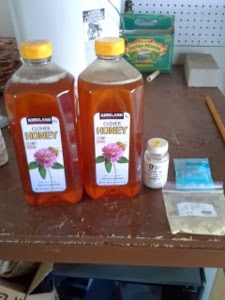 Appearance: Pale yellow and translucent. (Even though it doesn't come across in the photo.) Almost zero foam on the surface. Lots of small carbonation bubbles cling to the side of the glass. It could be mistaken for nearly flat Champagne or a glass of white wine.
Appearance: Pale yellow and translucent. (Even though it doesn't come across in the photo.) Almost zero foam on the surface. Lots of small carbonation bubbles cling to the side of the glass. It could be mistaken for nearly flat Champagne or a glass of white wine. The color is much light than that of the opaque, coppery-brown pre-fermentation cider. How does fermentation change the color and transparency of the cider?
Aroma: I still get a sulfury not from the yeast, and not a whole lot of apple-like smell. The Champagne yeast does seem to have imparted a kind of white-wine like smell that may obscure the apply quality. Still my wife said that it did have a sourish apple smell. She and I do seem to have differently calibrated noses.
Taste: It doesn't have a strong taste, but I would say this it does have a nice apple taste, and like the nose, some white-winey notes. It does not have a sour bite at all - the campden had its intended effect. I get almost no sweetness. It's very dry, as I was told to expect with Champagne yeast. Also the flavor seems to improve a little bit as it warms. It doesn't have any boozy note in the taste as it is likely around 4%-5% ABV.
Mouthfeel: Low carbonation. It's doesn't have a big body but fortunately doesn't seem thin and effervescent, like highly-carbed Champagne can. The aftertaste does seem to have an apple quality.
Overall: A pretty dry, low carbonation cider, with some apple flavor and quite some similarity to white wine. Some sulfur in the nose.
As yet, this cider is young. I will need to keep a few bottles around to see how it taste after a year of aging. I will probably make some cider again, though perhaps use a less attenuative yeast, and some sour apples. The sourness can accentuate the apple flavors.



